Stats Learning Theory Course Slides Notes

1. risk theory
1.1. learning algorithm & loss functions (1-1, 3-1)
f -> h, L -> R
Def: learning algorithm Ln (3-1)
Usage: from data to algorithms space

Def: weakly consistent / strongly consistent (3-1)

Note: \(\hat{h_n}\) is random variable since it completely depends on iid data when \(L_n\) is fixed. (3-1)

Def: loss (loss function) (1-1)

Example: the relation of max likelihood & loss function (1-10)

Example: (1-10)

1.2. loss functions

1.2.1. E-f-loss (1-1, 3-1)
Goal: we analyze what decide a good f function and what are the bounds between f and f star.
Def: E-f-loss (generalized expected risk) (1-1)

(3-1)

Def: min-E-f-loss (minimal generalized expected risk) (1-1)

Theorm: min-E-f-loss for binary classification is bayes classification
(1-1)

(3-2)


Proof: (3-2)

Theorem: min-E-f-loss for binary classification(3-2)

Proof: (3-2)

Note:

Def: other form of bayes (3-2)

Note: figure of bayes risk (from 3-2)

Theorm: E-f-loss - min-E-f-loss (1-1, 3-1)
Usage: find f to estimate f*
(3-2)

Proof:(3-2)

Note:(3-2)

(1-1)

Proof: (1-1)

1.2.2. E-$f_ $-loss (plug-in classifiers) (1-1, 3-2)
Goal: we analyze the usage of plug-in classifiers.
Def: Plug-in classifier: swe can see that \(\eta\) is what we what to estimate, the goal turns to find a better \(\eta\). (1-1)

(3-2)

Theorem: E-\(f_\hat{\eta}\)-loss - min-E-f-loss (1-1)
Usage: when using \(\hat{\eta}\) to find best f, instead of directly finding f, what's the bound?
(1-1)

Proof: (1-1)

Note: figure / pros & cons to use \(\hat{\eta}\) to minimize E loss (1-1)

(3-2)

Note: (3-2)

1.2.3. E-f-newloss (1-6, 1-7)
Goal: we analyze usage of different loss functions.
Def: E-f-newloss

Note: SVM

Qua: => elaboration
Usage: we can minimize E-f-newloss by minimizing the follows at every x/

Def: new elements to compute min-E-f-newloss, \(H(\eta)\) means the lowest point of all f, all x.

Note: SVM


Qua: when \(\phi\) is convex => \(H ^{-}(\eta) =\phi(0)\)

Def: classification - calibrated

Example:

Qua: necc & suff

Proof: too long
Qua: real gap is bounded by E-f-newcalibratedloss

Proof: too long
Example: in the case of SVM, \(\phi\) is a given convex function, therefore we can conpute \(H(\phi)\) and yield a upper bound for the real gap. which means when training performs good, the result will most likely be the same.

Example: adaboost is the same, \(\phi(a)\) is convex and we can again use theorem 2.2

Example: adaboost(1-13), a more detailed explaination, \(\phi\) is class-calibrated, so we can use theorem 2.2.


1.2.4. Em-f-loss (1-2,13, 3-3,4,5)
Def: Em-f-loss
(3-3)

(3-4) the best Em-f-loss h

Note: (3-3)

Qua: Em-f-loss converge to E-f-loss (1-13)

Proof: why E(empirical risk) = generalized : E(h) is actually P(y|x), so $E((h))=_n E(1(...))/n=_n p/n = p $

Note: (1-13)

1.2.4.1. empirical bounds (3-3,4,5)
Goal: In this chapter we'll discover the bounds for empirical loss, or in other words, how well can we train the algorithm if we use empirical algorithms?
This is the whole picture: that we use em-loss to estimate the loss function.During this section, we'll use different tools to bound between \(\hat{E}\) and E, such as VC & hoeffding bound, etc. (1-18)
1.2.4.1.1. uniform deviation bound
Goal: if we have bound generated by EPT, we have a goal proved.
Theorm:: => Em-f-loss - E-f-loss, uniform deviation bound (bound the performance of em)(not know h)(3-4)

Proof: (3-4)

note:

Theorm: => E-fem-loss bound case 2 unifrom devia bound (3-4)

Note:(3-4)

Theorm: => E-fem-loss probability bound2 (3-4)

Theorem => Em-f-loss bound 3, if zero error case (3-4)

1.2.4.1.2. vc bound
the bound of EPT generated by vc
Theorm:: => Em-f-loss vc bound 4 (3-5)

Note: that the right side can be bounded

Corollary:

Proof: follows from theorem using an argument like that when \(|H|< \infty\)
Corollary: this is obvious from theorem.

Theorm: => learnable (3-5)

1.2.4.1.3. bound improvement by approximation error
1.2.4.1.3.1. UAP & approximate error
Intro: decomposition to est ( discussed in above, basically random) + app ( not discussed before, decide by algorithm pool H). In this lecture we'll talk about app error (3-6)

Def: universal approximation property (3-6)
Usage: UAP is when H pool grows, the approximation error converge to 0.

Note:(3-6)

Theorem: special Hk consist of piecewise constant classifiers => (3-6)

Example:(3-6)


1.2.4.1.3.2. sieve estimators
Def: best estimate classifier from H (3-6)

Intro & Def:Strong Universally Consistent, why and what is a sieve estimator, basically to let the whole thing go to 0 simutaniously. (3-6)

Theorem: UAP & k(n) sequence => (3-6)

Proof: (3-6)

Corollary: similar to theorem => (3-6)

Note: (3-6)

Theorem: UAP + VC bound => (3-6)

Proof:(3-6)

1.2.4.1.3.3. rate of convergence
Def: rate of convergence(3-6)

Theorem:(3-6)

Note:(3-6)

Example: box-counting class (3-6)
1.2.4.1.4. Rademacher averages bound (1-18)
Def: RA
Usage: how well function class F align to random directions, as well as to provide a upper bound

Qua:

Qua:

Note:

Note: concern with loss function


1.2.4.2. empirical processing theory
Goal: to make Em & E close enough, Empirical Process theory allows us to prove uniform convergence laws of various kinds. One of the ways to start Empirical Process theory is from the Glivenko-Cantelli theorem. This leads to the question of whether the same idea can be generalized to other function classes.
1.2.4.2.1. Glivenko-Cantelli
This is where we'll start, by proving GC and go further, GC means that for certain class of mapping G, we have the following: and in the chapter after we'll generlize G .

1.2.4.2.1.1. empirical distribution function (book, 2-2)
Def: empirical distribution function
Usage: is a statistic
(book)

(2-2)

Qua: => range (book)

Qua: => other interpretation(book)

Qua: => limits (book)

(2-2)

1.2.4.2.1.2. GC class & theory (1-16, 2-2)
Def: GC class (1-16)
Usage: difference between P-GC is the supPn.

Theorem: GC theory
(1-16)

(1-17)

Note: this is equivalent(1-17)

(2-2)

(book)

Note: Fn and F is very close when n is large

1.2.4.2.2. generalized Glivenko-Cantelli (1-13,14, 2-6)
1.2.4.2.2.1. symmetrization lemma (2-5)
Lemma in this section is important to generalize GC.

Def : recall distribution function (2-5)

Def: Rademacher variables (2-5)

Lemma: => first symmtry bound the Fn-F(t) (2-5)

Usage: using two indenpendent stochastic process to set upper bound for one .
Example: (2-5)

Lemma: second symmtry => aallowsustoreplacethedifferenceFn−Fn′ withasingleempiricalquantity consisting of n observations. We can further bound the latter so that the bound is independent of the data ξ. (2-5)

Usage:using independent variables to set upper bound for GC (2-5)

Proof: (2-5)

1.2.4.2.2.2. generalized GC
Using Lemma above to prove GC
Goal: for every F, make Em & E close enough. we can first generalize the Glivenko-Cantelli theorem (a special F space).
Intro: what is and why we should use uniform convergence: (1-13, 1-14)
if there's only one function in F, we simply use law of large numbers, then we can prove convergence, but it is of no use.

Example: when F contains more functions and here the case is when dataset are separated, empirical risk are sometimes not convergence to real risk. (1-13)

Example: the GC theorem in function way (2-6)

Intro: using Lemma1 in 1.2.3.2.3 to empirical functions (2-6)

Usage: when we F specialize to indicators (2-6)


1.2.4.2.3. vc class and stuff
Vc & covering number are powerful tools to empirical learning.
######vc class (2-6,7, 3-5)
Def: vc class
Usage: vc class , C is a collection of sets,X is the largest set, Vc is:given n points from X, if subsets of C cannot separate X into \(2 ^{n}\) parts,then \(V ^{C}=n\), mind that we should go from n =1 to above, and see if we could find the x points that could be shattered by this set, if not we shop and set Vc = n. So basically, the larger Vc, the better C is in regards to shatting set X.
(2-6)

Example: $V ^{C} = 2 $ since given \(x1=1, x2=2\), you can't separate them. (2-6)

Example: half space (2-7)

Example: subgraph (2-7)

(3-5), nth shatter coeffcient is m(n), for all n < Vc, we say F/H shatters {x1...xn}

Example: (3-5)
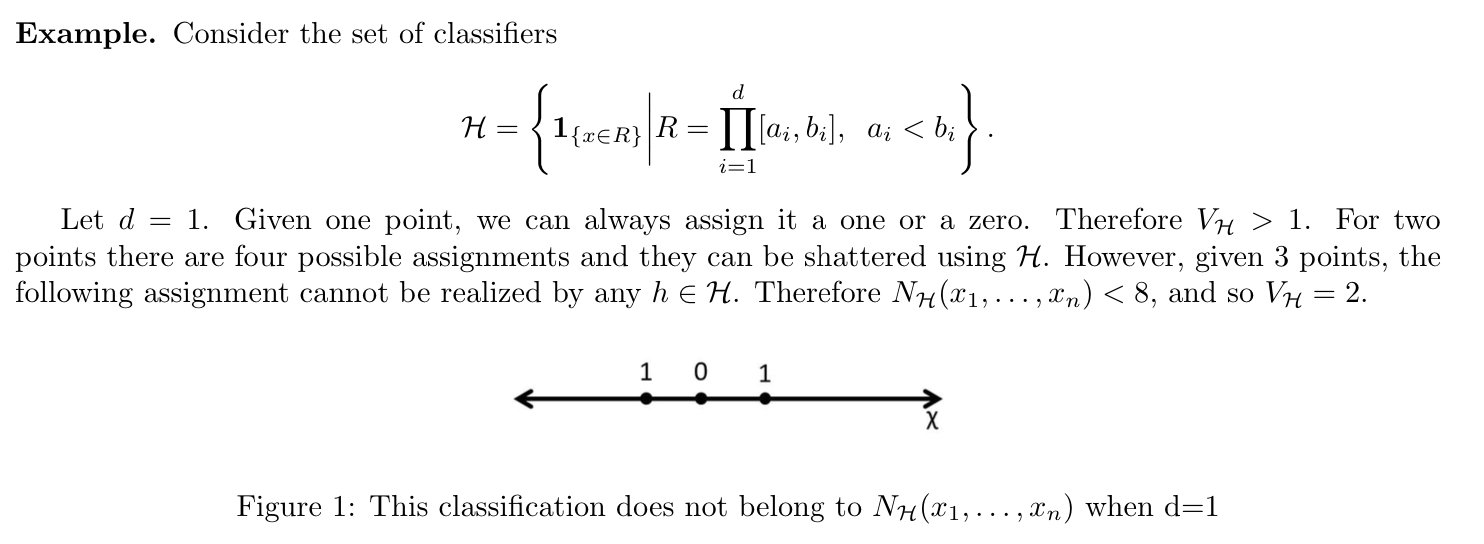


Example: (3-5)

Example: (3-5)


Lemma: => bound Vc for a broad family of classes

Lemma: => Sauer's the relation ship between m(n) and Vc
(3-5)

(2-6)

Proof: (2-6)

Note: that we can use VC to see Pn, use m(n) to indicate the \(2 ^{n}\) subsets of all, and we use lemma to get a upper bound of Pn0 (2-6)


Corollary: (3-5)

Corollary: (3-5)

Corollary: (3-5)

Qua: operation (2-7)

1.2.4.2.3.1. covering number (2-7, 2-8)
Def: covering number (a more powerful way than VC) (2-7)
Usage: a covering number is the smallest number of functions that can approximate any f with metric Q in F. Apparently larger N1, the more complex class F, the more powerful it is in regards to classification. Here N1 means F is constrained within \(L ^{1}(Q)\)

Note: not unique s (2-7)

Theorem: => apporximation lemma, giving an upper bound for covering number of VC dimension(2-8)

Usage: (2-8)

1.2.4.2.3.2. entropy
Def: metric entropy (2-7)
Usage: metric entropy is log N1.

Example: (2-7)

Proof: computing cover number for F. Using definition of covering number, constructing \(\hat{f}\) for F (2-7)


Def: totally bounded (2-7)

Def: entropy with bracking (2-7)
Usage: Np,B means the smallest of m pairs of functions that can approximate any f in F.

Qua: relation of metric & brackeing entropy (2-7)

1.2.4.2.3.3. vc theory for sets(3-5)
Theorm: VC theory => convergence guarantees for an empirical risk minimizing classifier when the VC dimen- sion of the classifier set H was finite. (3-5)

Corollary DKW

Qua: operation.

1.2.4.2.3.4. mono layer (a special classifier)(3-5)
Def: see page 8 of class_3 lecture 5
Theorm: => bound of expected shatter coefficient

Corollary: => convergence

1.2.4.2.4. P-Glivenko-Cantelli (for class F)
This is where we finally arrived at, the generalized GC.
Def: P-Glivenko-Cantelli class(2-8)

Def: envelop (2-8)

Theorem: => P-GC (2-8)

Note: intuition for condition of metric entropy (2-8)

Proof: way too long
Example: (2-8)

1.3. alternative loss functions
1.3.1. maximum likelihood
Def: maximum likelihood \(l(f(x_i),y_i)\)
Usage: turn to an alternative minimization goal, only available when the output is conditional probability

1.3.2. probably approximately correct (1-13, 3-4)
Def: PAC (1-13)
Usage: turn to an alternative goal.



Def: probability approximate corret condition (1-13)


Qua: PAC insights (1-13)

Def: PAC learnable (1-13)

Def: PAC definition 2 ( 3-4)

2. supervised algorithms
2.1. decision theory
Def:


Note: model choosing -> loss function choosing -> optimization (training) -> validation
2.1.1. model
Def: model
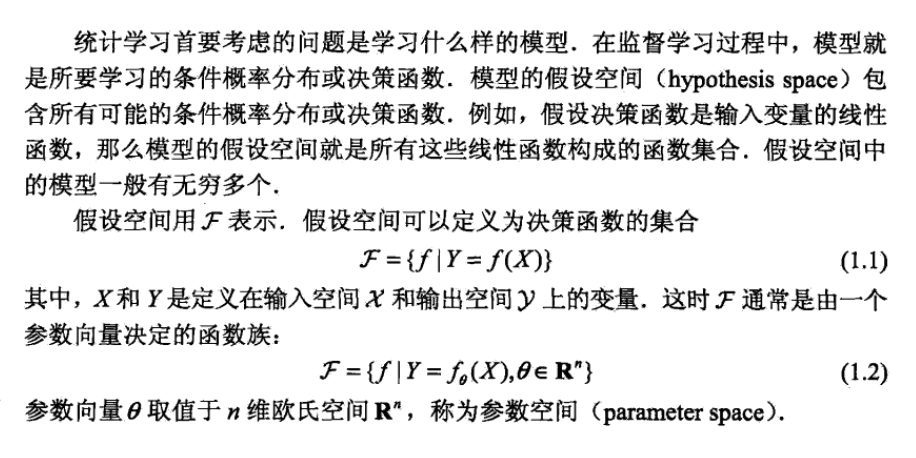

2.1.1.1. generative model
Def:

Qua:

2.1.1.2. discriminative model
Def:

Qua:

2.1.2. loss function
Def: loss function

2.1.2.1. E f loss
Def: E f loss function

- Note: goal of training is to make this small
2.1.2.2. Em f loss
Def: Em f loss

- Note: E f loss can't be obtained
Def: regularization
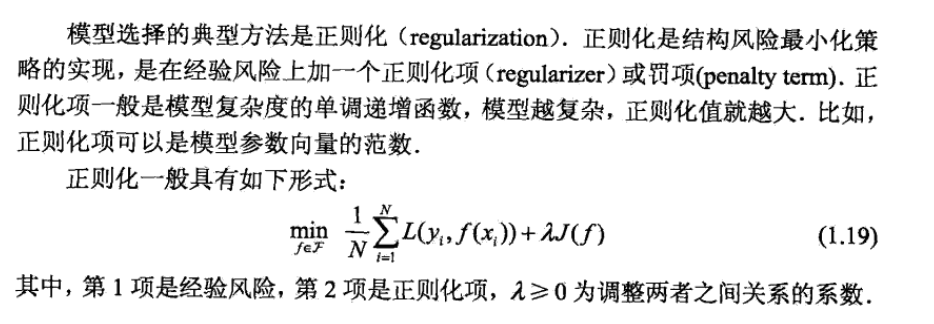

Def: Em-f*-loss

Theorem: upper bound

2.1.2.3. max likelihood
- Def: max likelihood
2.1.3. optimization algorithm
Def:


2.1.4. validation criteria
####TN & TP
Usage: criteria for 2-classification
Def:

Def


2.1.4.1. accuracy
Usage: classification for > 2
Def;
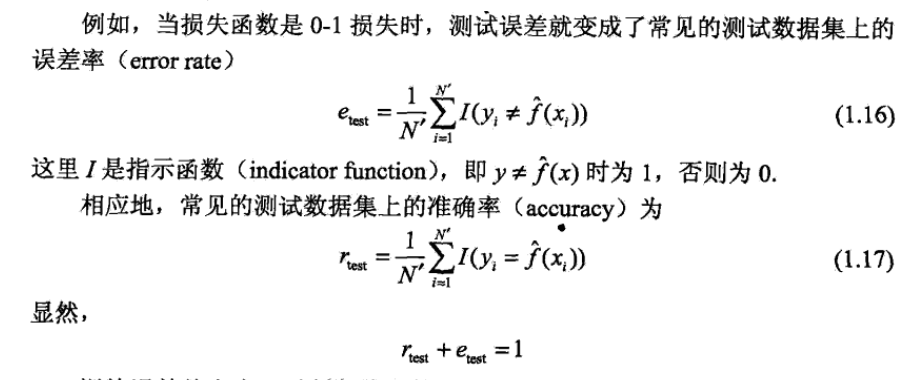
2.1.5. validation improvement
2.1.5.1. validation set
Def:

Qua: cons

2.1.5.2. leave one out validation
Def:

Qua: pro


Qua: special for regression
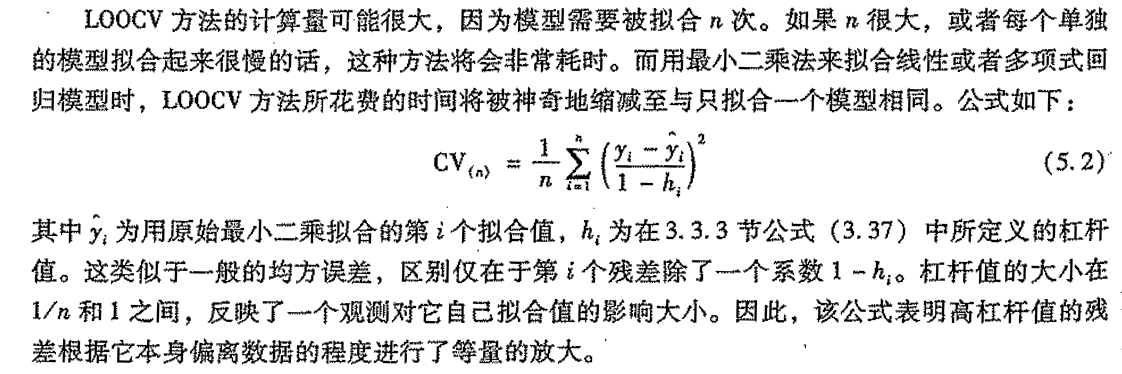
2.1.5.3. leave k out validation
Def:

Qua: balance


2.1.5.4. bootstrap
Def:


2.1.6. high dimension problem
Def: high dimension data

Def: high dimension problem -> regression

Def: problem2

Def: problem3
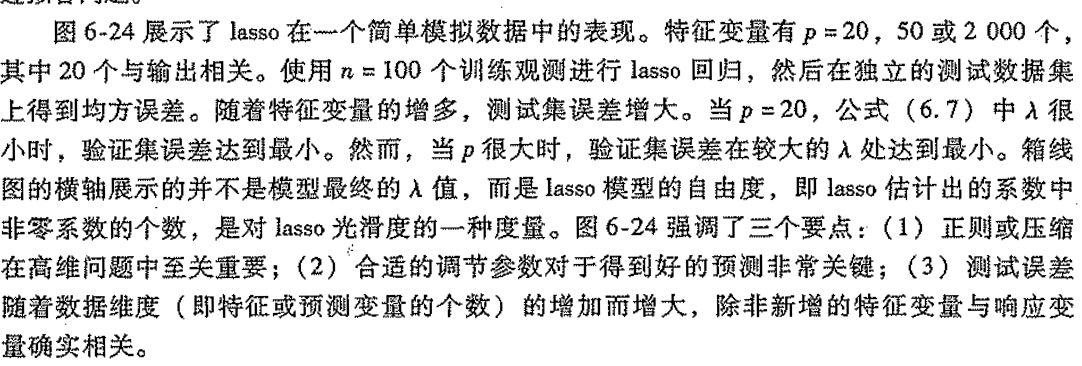



2.2. knn algorithm
Usage: discriminative model
Def: choose the most appeared class in x's neiborhood
$$ p(y=c_j|x) = I[c_j=c {x_i N_k(x)}^{} I(y_i=c_j)]
$$

Note:

2.2.1. loss function
Def: 0/1 loss function
\[ L(f, x, y))=I[y \neq f(x)] => E(L(Y,f(X))) \]

- Note: how to reach \(f\): preset structur: neighbor voting
- note: how to get res: intuition.
- Note: how to reach \(\hat{f}\): to minimize EmL, we find that if we use the result from dataset \(\sum_{x \in N_{k}(x)} I\left(y_{i}=c_{j}\right)\) then it is equivalent to trainning EmL(f, X, Y).
2.2.2. alternatives & improvements
2.2.2.1. distances
Note: different distances
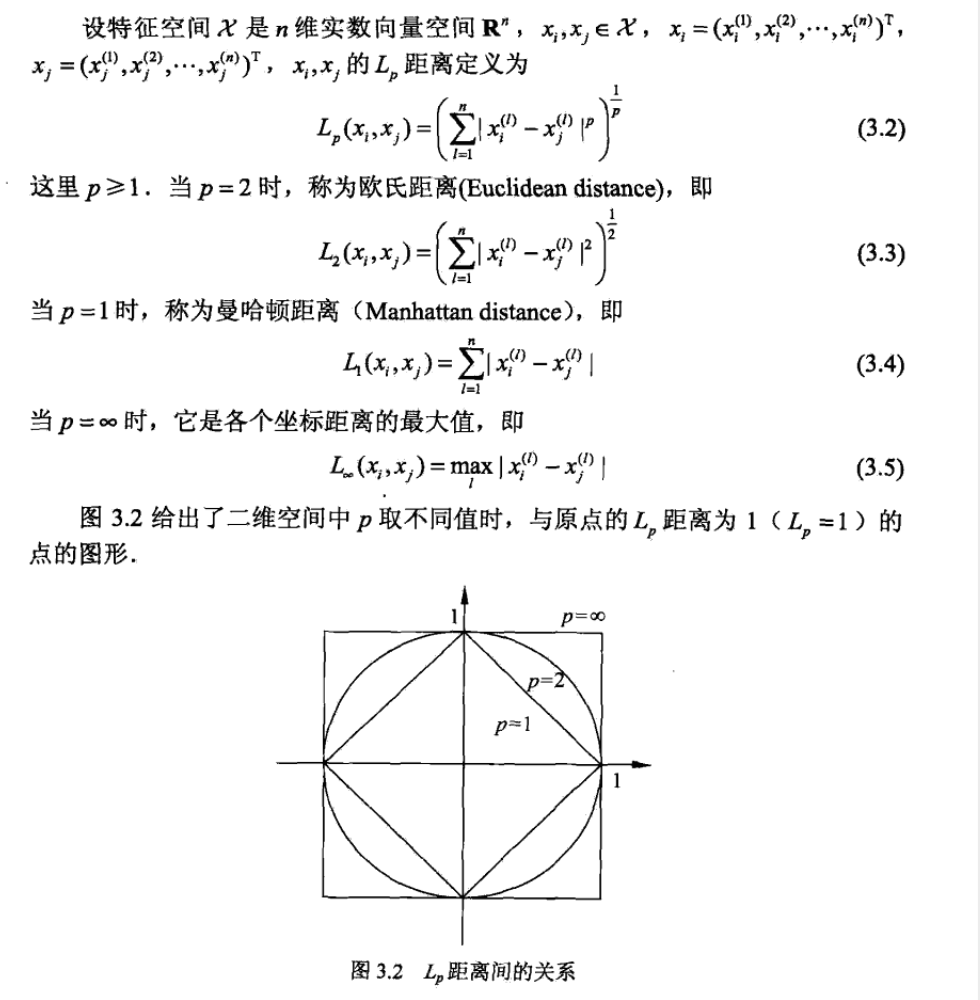
2.2.2.2. choose of k
Def:


2.2.3. implementation
Def: kd tree

Def: how to build


Note: 1 layer => 1 dimension, 2 layer => 2 dimension, ...
Note:

Def: how to use kd tree


2.3. perceptron algorithm
Usage: discriminative model
Def: The perceptron algorithm performs pattern classification when F is the class of linear threshold functions.
$$ p(y=1|x) = I[f(x)=sign(w ^{T} x)>0]
$$

Def: how to build

Note: figure of perceptron

Qua: One important feature of this algorithm is that it only uses inner products of the data points.
let, where \(n_i\) is the time that \(x_i\) gets updated.
\[ \alpha_i = n_i \eta \]
so we have
\[ w_N = \sum_{n=1}^{N} \alpha_i y_i x_i \\ b_N = \sum_{n=1}^{N} \alpha_i y_i \]
the prediction rule becomes
\[ \hat{y}_i = sign(w_N ^{T}x _{i}+b_N) = sign( \sum_{j}^{}a _{j}x _{j} ^{T} y_jx _{i}+b_N) \]
updates becomes (i is one of the misclassified points)
\[ a _{i} ^{(t+1)} = a _{i} ^{(t)} + \eta \]

Note: from this quality we can see the inspiration of kernel, that we only need the inner product of xixj, with the quality of readiness of computing inner product after projection, we can use kernel to get a more complex model

2.3.1. loss function
Def:
\[ L(w,x,y) = -y(wx+b) I[f(x)y<0] =>-\sum_{x_{i} \in \mathbb{M}} y_{i}\left(w \cdot x_{i}+b\right) \]
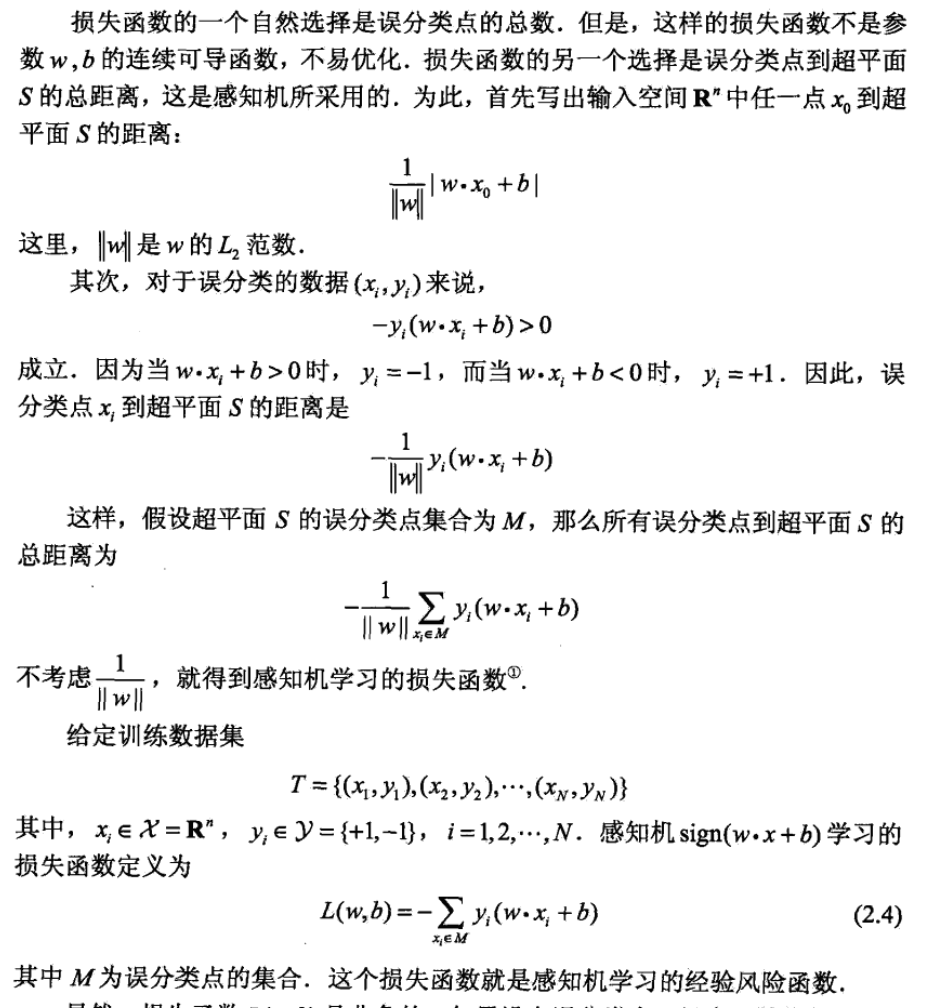
Note: how to reach \(f\): preset structure: linear model
note: how to get res: intuition.
Note: how to reach \(\hat{f}\): minimizing EmL: which is distances of mis classified nodes, we want them to classify correctly=>loss=0. note that we don't use the normal loss functions. Training = partial gradient descent(point by point).
2.3.2. optimization algorithm
Def:gradient descent


2.3.3. convergence
Theorem: complexity of the algorithm to converge.
Usage: result gives a bound on the number of steps in terms of some properties of the data.

Note: perceptron complexity may not be linear, it is possible it do not terminate after a long time

2.3.4. evaluation
Lemma: linearly independent => seperatable data

Proof:

Theorem : The main theorem in this section shows that for any prediction rule (from the class of linear threshold functions), there is a probability distribution that is linearly separable, but for which the prediction rule does poorly when averaged over all training data sets.
Usage: we can compute this lower bound, to estimate the risk for this threshold function.

Proof: too long
Note 1: see this bound as minimax lower bound, meaning that whatever \(f _{n}\) you choose, there exists some part of the training dataset that yield result with lower bound.

Note 2: generalization using VC dimension.

Theorem: If we restrict our attention to probability distributions that have a large margin, we can prove an upper bound for the risk of the perceptron algorithm:

Proof:

Theorm: In the above theorem, we were maximizing over all probability distributions. If we restrict the maximization to be over those probability distributions having a large margin we can obtain a better lower bound:

Proof:

2.4. support vector machine
Usage: special form of perceptron(same structure) where distance is maximized.
Def: function distance1

Def: geometry distance
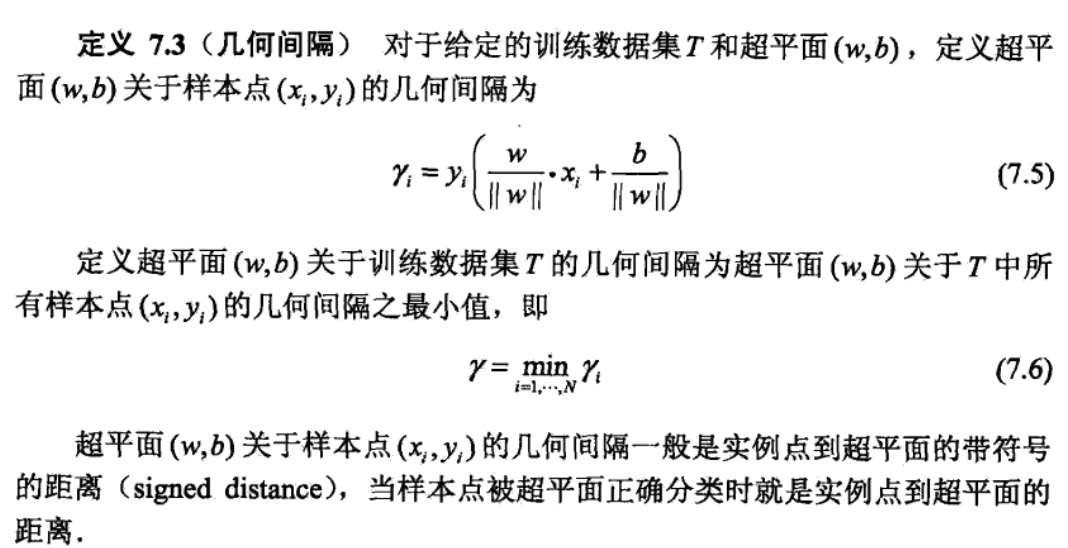
Qua: relation ship with distance 1, we know that geometry distance is not affected by w alone.
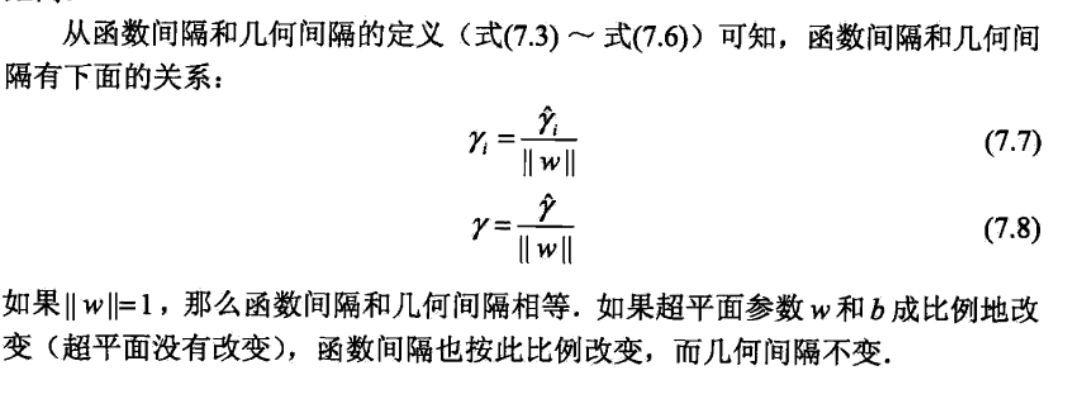
Def: support vector machine model
$$ p(y=1|x) = I[f(x)=sign(w ^{T} x)>0]
$$

- Note:

2.4.1. loss fucntion
Def: loss function for soft C, if hardmargin(basic form), lambda = 1/infinity
\[ L(w,x,y) = ||w||^2+[1-y(w*x+b)]_+ =>\sum_{i=1}^{N}\left[1-y_{i}\left(w \cdot x_{i}+b\right)\right]_{+}+\lambda\|w\|^{2} \]

- note: that [1-x]+ vs I(x)x>0. 这里I[x]可以用于可分,因为它最少就是0,是0的时候就是可分的。同理我们也可以用硬间隔把[1-x]+前面的系数调成正无穷,那么效果是和I[x]一样的。只不过我们多加了||w||这项,这项是为了最大化间隔。
- note: how to get f: preset, linear model
- note: how to get res: intuition.
- note: how to get \(\hat{f}\) : by minimizing EmL: mimizing not only the misclassified distance(hinge loss), but also the parameter to make distances as large as possible, training = optimization(IIS. newton).
2.4.2. optimization
2.4.2.1. basic
Qua: basic transformations
trans: other form \(\left \| w\right \|=1\)

MWpfw8.png trans: other form \(\left \| w\right \|=1/ \gamma\)

MWpOmV.png overall

2.4.2.2. dual
Def:
lagrange function

goal: max min

get lagrange dual problem ( solve the min problem)
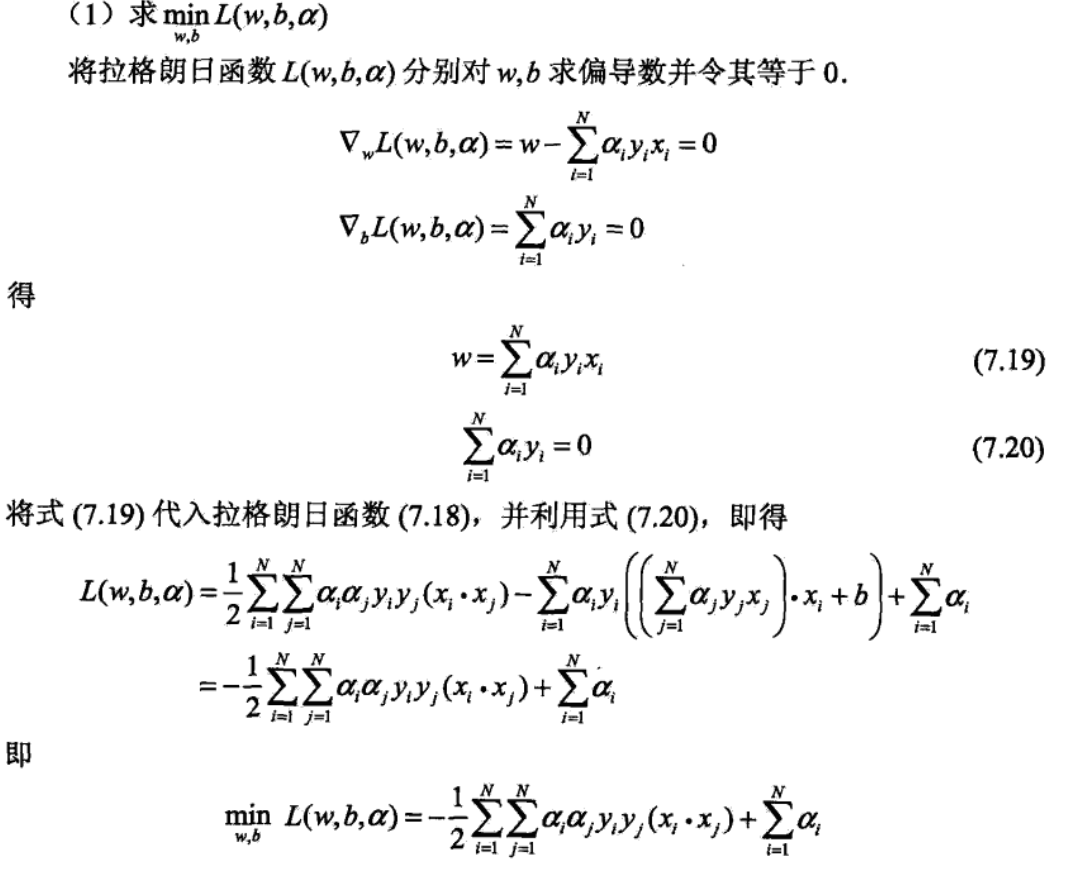
final: solve lagrange dual (max problem)

recall slackenss for dual problem, this show that the those with ai(penalty loss) \(\neq\) 0, are exactly those in the margins. 算法解只由支持向量决定。

recall the kernel stuff, we can use kernel to efficientlly solve this, for more kernel stuff turn to 2.2.2

overall


2.4.3. alternatives & optimization
2.4.3.1. kernel SVM
Def: dual problem & kernel function
dual problem (only inner products determines solution)

Qua: kernel function can reduce complexity of dual problem.( further discussion can be find in linera algebra)
Usage: 由此看出,即使没有kernel,只要找到映射关系,我们仍然可以实现低维空间映射到高维空间,进而通过高维向量内积运算来寻找最佳分割超平面。但是,kernel的引入,降低了向量内积运算的计算复杂度。无论我们映射到几维空间,我们只要把原有维度代入核函数,就能等价于高维上的内积运算。极端的情况下,特征空间映射到了无穷维度空间,如果没有核函数,根本无法计算出映射后的向量内积。
(映射到新的特征空间后的内积=原空间核函数)
https://blog.csdn.net/zhangjun2915/article/details/79261368
k(xi, xj) is the kernel function of inner product of xi, xj
Def: kernel function


Note: k = HxH->R, we project nodes to higher dimension and do SVM in higher dimension, the results are got by kernel inner project.
Example:

Example: polynomial kernel
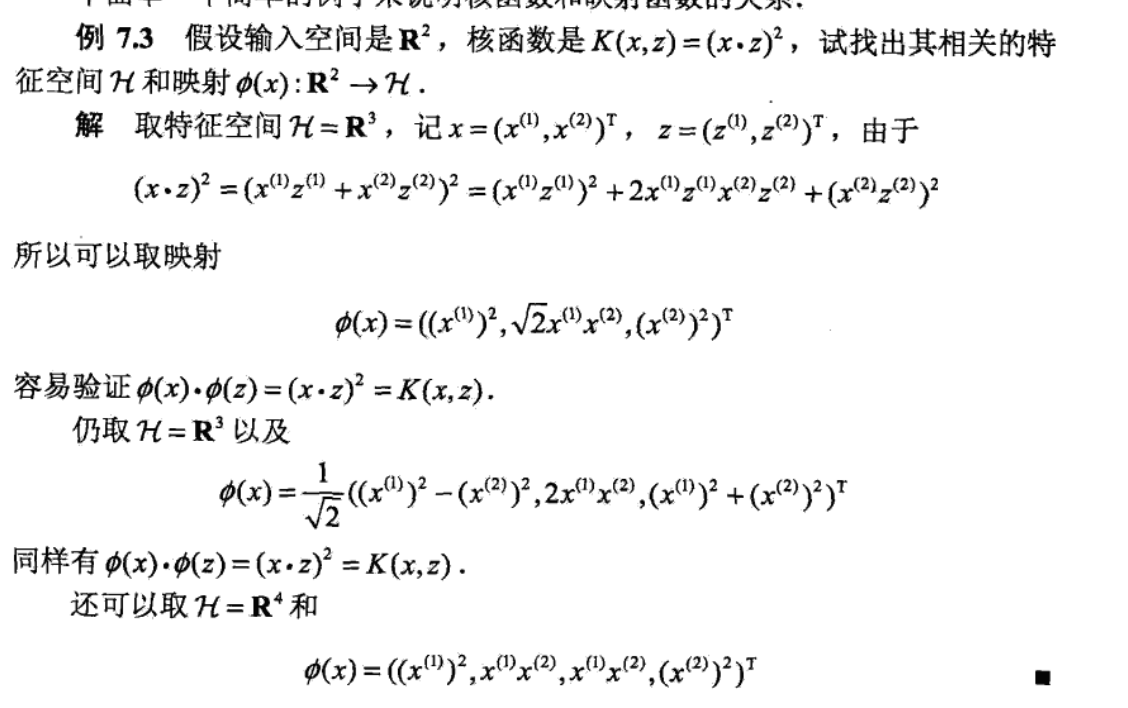
Example: gaussian kernel

Theorem: what kind of K is kernel(can be split

Def: f is a function space : R->R

Def: inner product on S: SxS->R

Qua: the definition of f and innerproduct makes S a RKHS. S is a space (\(\phi\), K, f, ), where f & are self-defined function & inner product. note that this quality does not come from K or \(\phi\), K could be any thing, RKHS comes from (f, *).


def:

2.4.3.2. primitive SVM
Usage: a more natural way
Def: primal SVM,

lagrangian functiion

getting lagranian dual function

lagrangain dual function

dual problem

this problem can actually be solved by hand: first solve \(\beta = \sqrt{1/4 \left \| \sum_{i}^{}\lambda _{i}y _{i } x _{i}\right \|}\), then we get the following

interpreting results

2.4.3.3. soft C-SVM
Usage:

Def: soft SVM

Qua: basic transform
trans: change |x<1| to (1-x)+ , basiclly is the same .

trans: slack variable


lagranrian function => dual lagranian function (solve min)
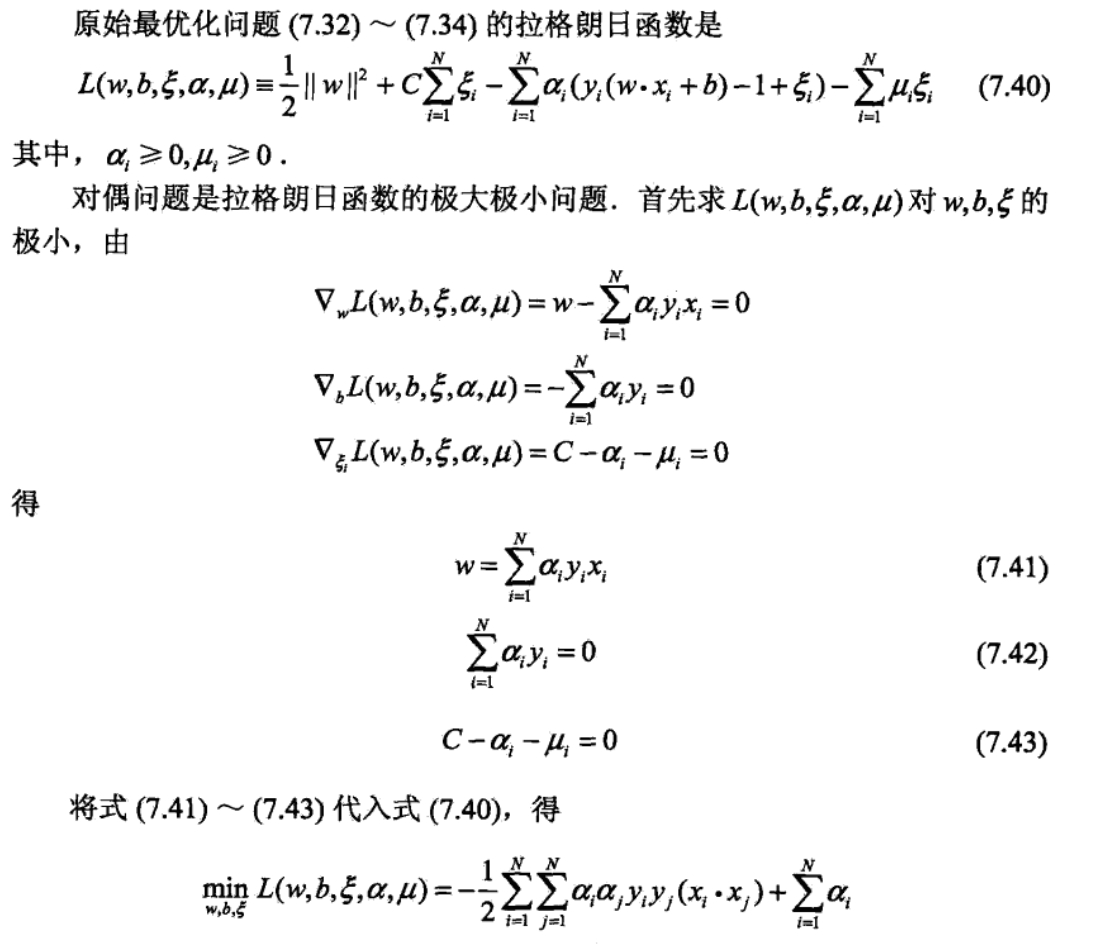
dual problem (solve max)



choose c

overall

Note: photo of soft support

Qua: interpreting in another way( loss function + regularization)

2.4.3.4. soft $ $-SVM
Def: a more interpretable way, since \(\nu\) is more easy to set.

Qua: basic transition
slack variables

lagrange dual function

dual problem

insights for slackness

Qua: interpretation of \(\nu\) : we can interpret \(nu\) as being approximately the fraction of data that are margin errors.
[](/Users/huangbenson/Library/Application Support/typora-stats_theory(https://tva1.sinaimg.cn/large/006y8mN6ly1g94litz5uxj316604g3zx.jpg)
Qua: \(\nu\) and C SVM are the same

Proof:

2.4.3.5. $ $-sensitive SVM (1-10)
Def: a relaxation of loss function

2.4.4. convergence
Theorem:

2.4.5. relationship with logistic regression
Def:

Note:


2.5. discriminant algorithm
2.5.1. LDA: by distance
Def: distance
\[ p(y=m|x) = I[d(x,G_m)=min_m] \]

Algorithm:

note: f preset structrue, minimize distance
note: f ha comes from computing parameter of dataset=>distance
2.5.1.1. if \(\sum1 = \sum 2\)
Algorithm:
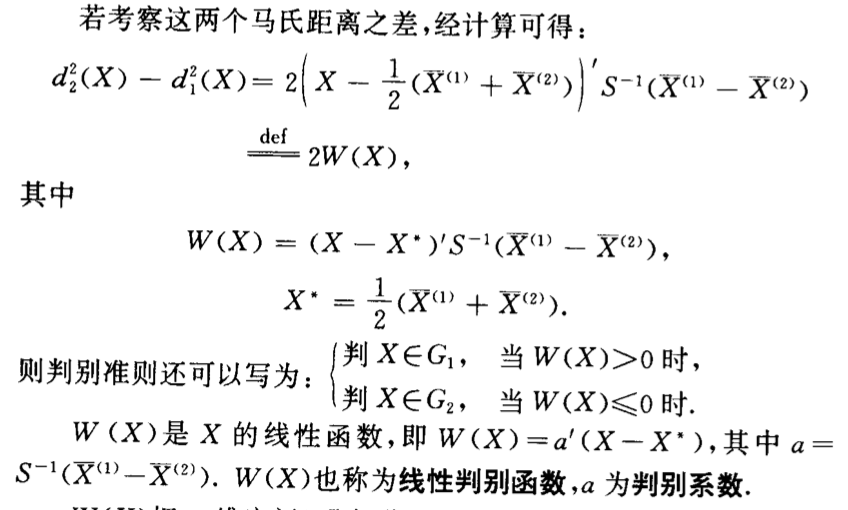
2.5.1.2. if \(\sum1 \neq \sum2\)
Algorithm:


2.5.1.3. if more than 1
Algorithm:

2.5.2. QDA: by general distance
Algorithm:

2.5.3. by max posterior (estimate)
Algorithm: not similar to logistic, logstic is a distribution in whole & linear model, not using full probability expansion. This is similar to bayes => except this is exp normal model, bayes is discrete.


2.5.4. by bayes
Def:


Def: miss classification loss

Def: total miss classification loss

Theorem: the main theorem of bayes classification


Corollary:

2.5.4.1. if \(\sum\) all the same (gaussian)
Algorithm:

2.5.4.2. if not all the same (gaussian)
2.5.5. by Fisher
Def:
Usage: adding projection procedure to separate the data.

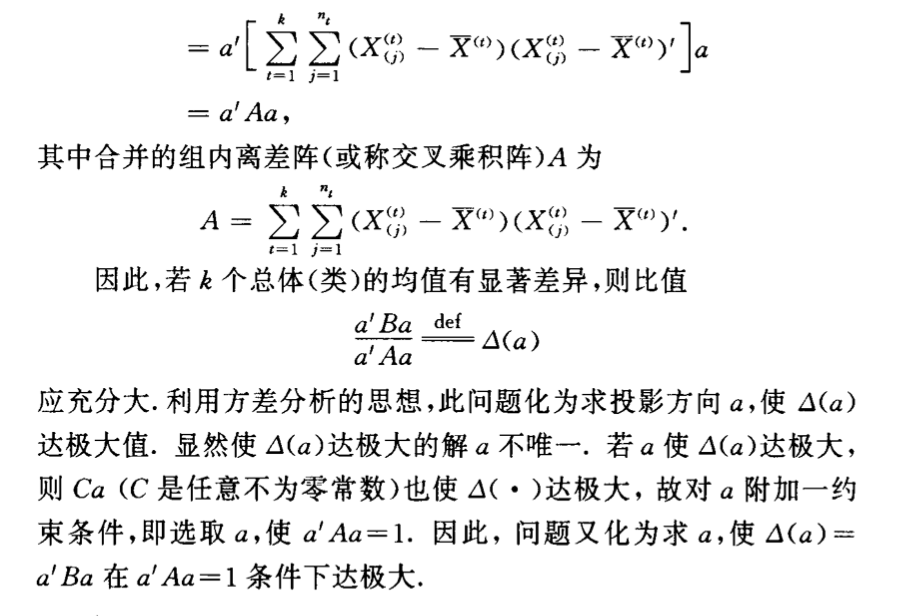
Theorem: the best direction

2.5.5.1. r=1
2.5.5.1.1. k=2
Algorithm:

2.5.5.2. r=?
Algorithm:


2.6. bayes algorithm
Usage: generative model
Def:
\[ P\left(Y=c_{k} | X=x\right)=\frac{P\left(Y=c_{k}\right) \prod_{j} P\left(X^{(j)}=x^{(j)} | Y=c_{k}\right)}{\sum_{k} P\left(Y=c_{k}\right) \prod_{j} P\left(X^{(j)}=x^{(j)} | Y=c_{k}\right)}, \quad k=1,2, \cdots, K \]
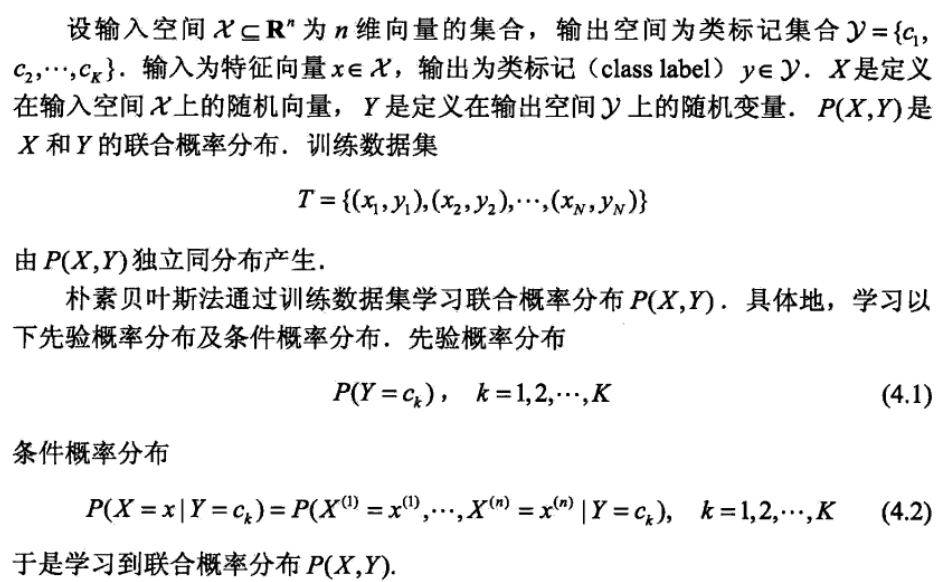
Note: we have to assume that X is independent in every dimension(every dimension is a feature)

Def: using kernel to interpretate

2.6.1. loss function
Def: 0/1 loss
\[ L(f,x,y)=I[{y \neq f(x)}]=>E(L(Y,f(X))) \]


- Note: how to get f: bayes does not have a presumed structrue like perceptron / knn, it(f) derives from the basic rule of conditional probability
- note: how to get res: it derives from minimizing EL with 0/1 loss function. Actually every algorithm that uses argmax post probability is minimizing EL.
- Note: how to get \(\hat{f}\): instead of minimizing EmL, we use max likelihood to get $ $.
2.6.2. optimization algorithm
Def: max likelihood


Note: that here we assume discrete feature of X, and the derivation is here : https://blog.csdn.net/weixin_41575207/article/details/81709379
Note: example


2.6.3. alternatives & improvements
2.6.3.1. laplace smooth
Def: laplace smooth

Note: example

2.7. logistic regression (1-13)
Def: distribution

Note:

Def: logistic regression model
\[ P(Y=1 | x)=\frac{\exp (w \cdot x+b)}{1+\exp (w \cdot x+b)} \]


Def: logit = log(p/1-p)

2.7.1. loss function
Def: loss function = - log(likelihood)
\[ L(f,x,y) = -log( \prod_{i=1}^{N}\left[\pi\left(x_{i}\right)\right]^{y_{i}}\left[1-\pi\left(x_{i}\right)\right]^{1-y_{i}} ) \]
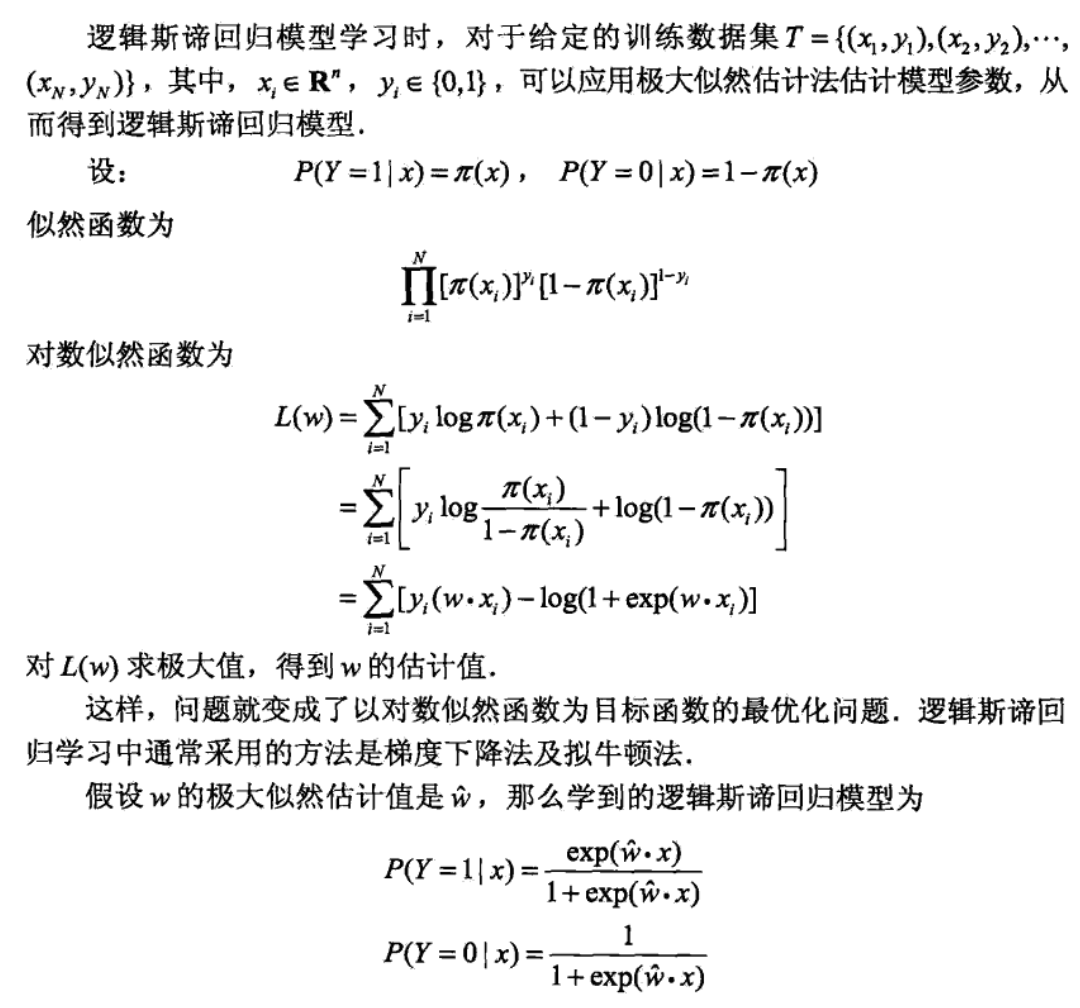
Note: likelihood function is p(y|x) not p(x,y) since we maximize w, adding p(x) makes no difference. In one word, we save all parts containing w.
Note: how to get f: preset structure: logistic distribution
note: how to get res: same as bayes?
Note: how to get \(\hat{f}\): maximize likelihood/ minimize EmL to get $ $
2.8. max entropy algorithm
Def: special function

Qua: E


Qua: E is used to test if p(y|x) is empirical p(y|x)(if p(y|x) suits the dataset)

Def: model
\[ p(y|x) = f(x,y) \text{ 代求} \]
- Note: that this model does not have any form of structure.
2.8.1. loss function
Def: loss function
\[ L(P,x,y) = -\sum_{x, y} \tilde{P}(x) P(y | x) \log P(y | x) \]

Note: note that this model maximize H(P) = make y as smooth & normal & equal as possible
Note: how to get f: no preset form!!
note: how to get res: same as bayes.
Note: how to get $ $ : use empirical conditional entropy and solve optimization problem(training), traning = optimization.
2.8.2. optimization
2.8.2.1. dual problem
Def: this is the result of max entropy problem(p,w relationship, w still needs to be solved). Notice that this looks exactly like logistic regression.
\[ \begin{array}{c}{P_{w}(y | x)=\frac{1}{Z_{w}(x)} \exp \left(\sum_{i=1}^{n} w_{i} f_{i}(x, y)\right)} \\ {Z_{w}(x)=\sum_{y} \exp \left(\sum_{i=1}^{n} w_{i} f_{i}(x, y)\right)}\end{array} \]
the original maximization problem

the minimization problem

dual problem, here we go from solving P => solving w => 把w带回P,得到P(w),其实就是本来直接可以解P但是不好解,现在换个对偶问题解w,然后带回p和w的关系式得到P。这里的x,y指的是可能取值而不是变量。而且求导是对某一个x,y求导,这里写的是对所有x,y对求导。

solve min problem by first order rule, get p,w relationship. note that we get derivation with each pair of x & y, it is equivalent to getting with 1 pair.



solve the outside max problem, get w.

get back p(w)

2.8.2.2. max likelihood
Usage: max likelihood = max entropy

Def:
start from likelihood function,why in this form: https://blog.csdn.net/wkebj/article/details/77965714

likelihood + p,w relationship => a function we need to maximize f(x,y,w)

dual problem => a function we need to maximize f(x,y,w)

2.8.3. IIS
Usage: similar to gradient descent

Def:
2.9. ensemble algorithm
Def: ensemble methods

2.9.1. boost
Def:


2.9.2. adaboost algorithm
Usage:

Def: adaboost algorithm


Note: explain why we do this way => update weight + training.


2.9.2.1. loss function
Def: general additive algorithm


Def: loss function = exp
\[ L(f,x,y) = exp(-yf(x)) =>\sum_{i=1}^{N} \bar{w}_{m i} \exp \left[-y_{i} \alpha G\left(x_{i}\right)\right] \]

Note: how do we get f: from equal distribution (no preset structure)
note: how to get res: intuition.
Note: how do we get \(\hat{f}\): by optimizing exp loss function each step.(这个损失是整体的,也就是大目标就是为了让指数损失最小)

Theorem: use gradient decent to explain adaboost, THIS IS THE SAME IDEA AS ABOVE
Usage: iteratively solving adaboost is equivalent to minimizing the true loss function of \(e ^{-YF _{T}(x)}\)

img Proof:

img Note: loss function: For every t from 1 to T, we can expand the E(exp(-YX)) thing, and we can see that adaboost is minimizing Eexp(YFT(X)) at every step, thus the we are using step-wise gradient decent to optimize the Eexp(-YX).
The whole picture: So this is the idea of adaboost, we choose fT to minimize eT as a step-wise gradient descent, then we find out we can see adaboost as E(-YX) in whole, so we choose \(\alpha_T\) to make that happen.

img 
img
2.9.2.2. optimization
- Def: gradient descent .
2.9.2.3. convergence
Theorem: there exist upper bound for loss function of each step, if database conditions are met.

img Proof:

img Theorem: for all classification upper bound for loss

Usage: the theory merely use update information=>tells us if we update weights in this way, how do we train Gm

Proof:
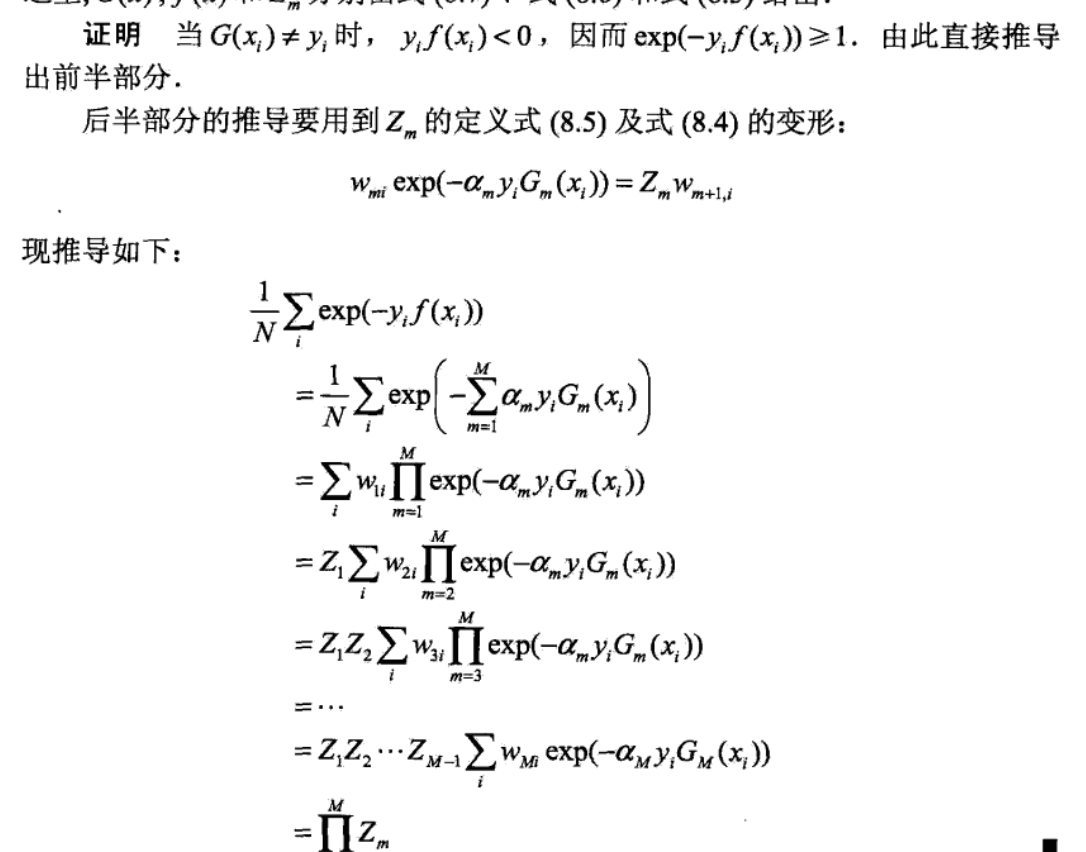
Theorem: for 2-class

Proof:

Corollary:

Usage: if we update this way + training each round constrain \(e_m\) to a constant, then algorithm converges in exp rate.

2.9.2.4. alternatives & improvement
2.9.2.4.1. generalized
Def: generalized adaboost:
Usage: in adaboost, we use exp(-YX) as loss, here we can have different options and still implement the step-wise adaboost core idea: we see J(F) as the loss, F is the variable, and each step we take \(F+\alpha _{t}f _{t}\)

img recall: (convex optimization)

img Algorithm:

img
2.9.2.4.2. boosting tree
Def:

2.9.2.4.3. gradient boosting
Def:

- Note: we can imagine gradient descent is using one model and doing descent by updating weight, and gradient boosting is using gradient descent by adding new model. \(f(x) = w1x+w2x+w3x\) vs \(f(x) = f1(x) +f2(x) +f3(x)\) , key point here is that f1(x) additive model is more flexible and differs from node to node even they share the same growing rate at same point(their derivative is the same).
2.9.2.5. relationship with logistic regression
Qua: similarity to logistic regression (1-13)
using taylor expansion we can see that the first elements are the same (\(ln(1+e ^{-2a})\)+1-ln2 & e(-a))

img e(-a) is above

img differences: 1) e(-a) are larger 2) adaboost is approximation of max-likelihood logistic regression with larger penalty.

img
2.10. regression tree
Def:


2.10.1. loss function
Def: loss = RSS

2.10.2. optimization
choose Xj & separate point to make RSS smallest

repeat


overall

regularization



2.11. decision tree
Usage:

Def: same, only node value = 1/0
2.11.1. loss function
2.11.1.1. error rate
Def: split into 2 to make loss1+ loss2 small. remember loss1 & loss2 are all in forms below. error ate

note: how to get f: preset structure: tree model
note: how to get res: intuition
note: how to get f ha: minimize EmL = loss + weight, by spliting tree.
2.11.1.2. information gain
Def: entrophy

Qua:

Note: example

Def: conditional entrophy

Def: information gain

Note: choose node with largest information gain (when constrained in A, entrophy drops)

2.11.1.3. information gain ratio
Def:

2.11.1.4. gini
Usage: gini is different from IG, but similar
Def:


- Note: the smaller the better
2.11.1.5. cross entrophy (no)
Def: cross entrophy

- Usage: since entropy is a constant, we only need to minimize cross entrophy
Def: KL = cross - entropy

- Usage: to determine differences between distributions
2.11.2. implementation
2.11.2.1. ID3
Usage:

Def:


- Note: that each path contains no duplicate features.
2.11.2.2. C4.5
Usage:

Def:

2.11.2.3. CART
Usage: binary tree!!

Def:


2.11.3. alternatives & improvement
2.11.3.1. trimming
Usage: overfitting


Def:


- Note: start from all leaves, and trim children if tree+chidren cost more than tree, this is likely since |T| is in loss function.
2.11.3.2. bagging tree
Def:

2.11.3.3. random forest
Def:


Qua: difference with baggin

2.11.3.4. boosting
2.12. dnn algorithm
2.12.1. regularization
3. unsupervised algorithms
3.1. clustering analysis
- Usage: given => data(X1,X2,...XN), output=>(X1,cluster)...(XN,cluster)
3.1.1. transformation
Def:

img 
img
3.1.2. distances
3.1.2.1. between samples
Def:

img 
img 
img
3.1.2.2. between features
Def:

img 
img
3.1.2.3. between clusters
Def:

img 
img 
img 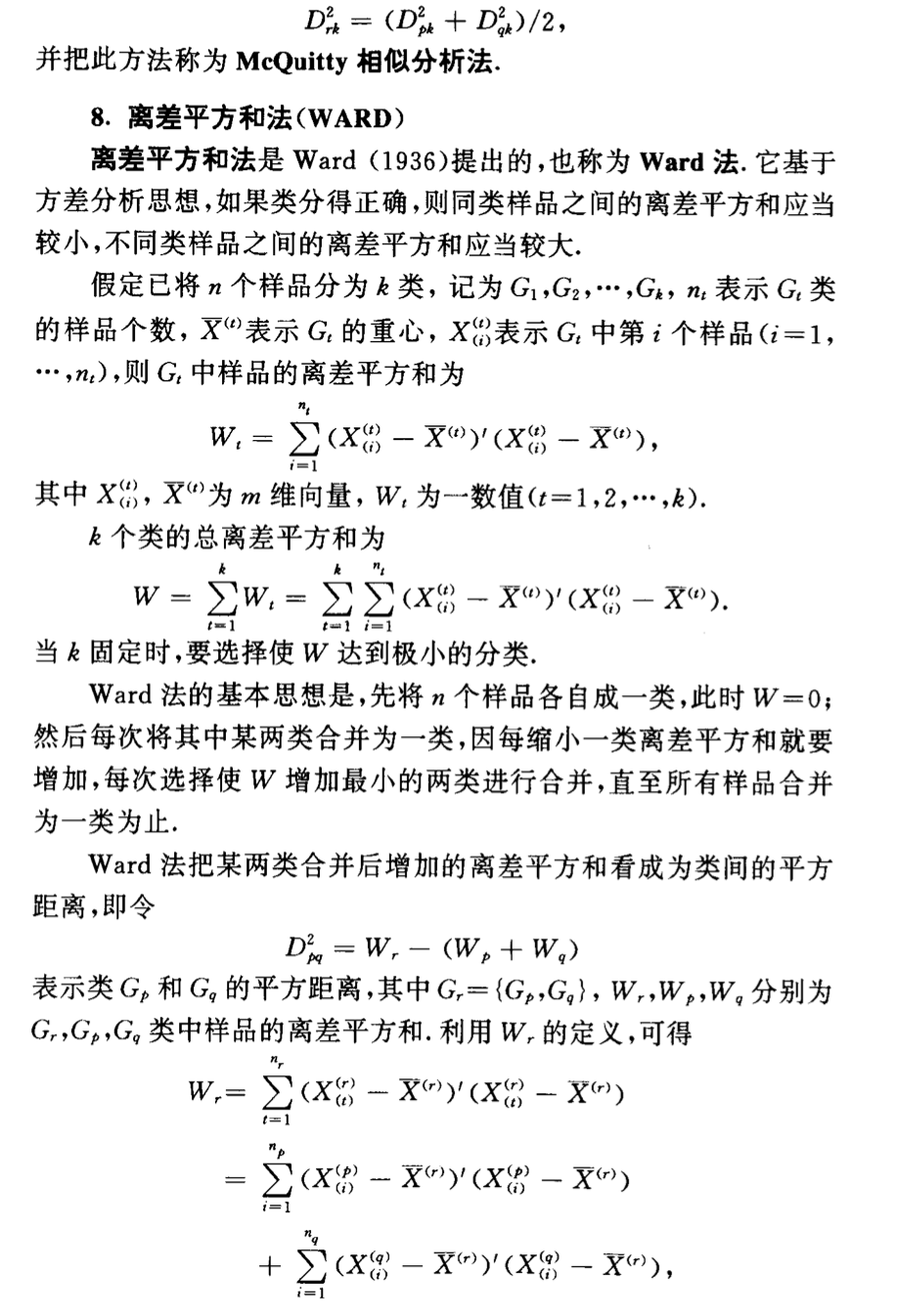
img 
img Theorem: overall:

img 
img
3.1.3. hierarchical clustering
Algorithm:

img 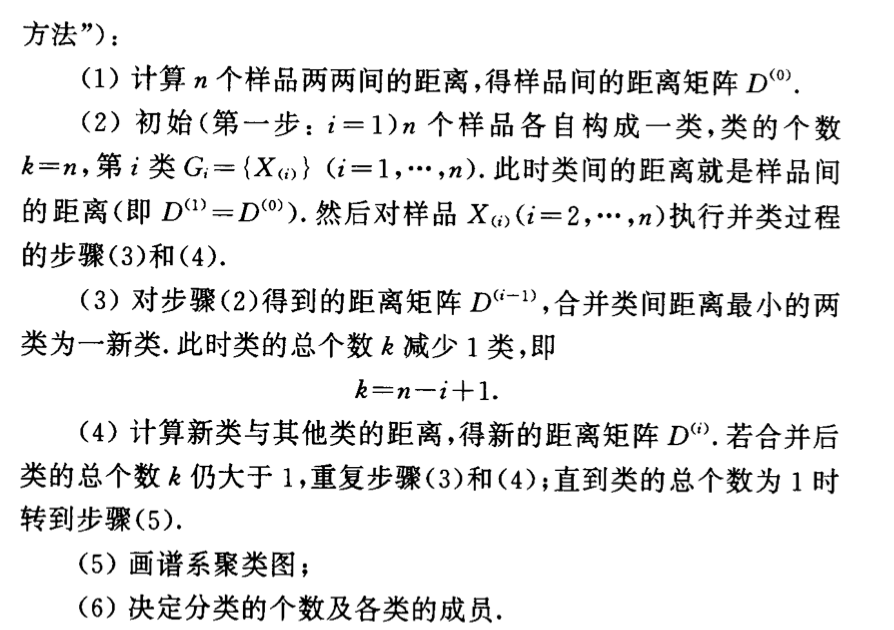
img Qua: => distance are mono

img Qua: => s

img
Qua: how to set the cluster number
P245
3.1.4. dynamic clustering
3.1.4.1. batch wise
Algorithm:

img 
img
3.1.4.2. sample wise(kmeans)
Algorithm:

img 
img
3.2. principal component analysis
3.2.1. PCA
Usage: given data(X1...XN), output datalessdimension(X'1...X'N)
Def: principle vector

img Note:

img Qua: ways to compute

img 
img 
img Qua:

img
Def: 因子负荷

img 
img Qua:

img
Qua:

img Def: total variance

img Def: contribution

img Def: contribution2

img
3.2.2. standardized PCA
Def:

img Qua:
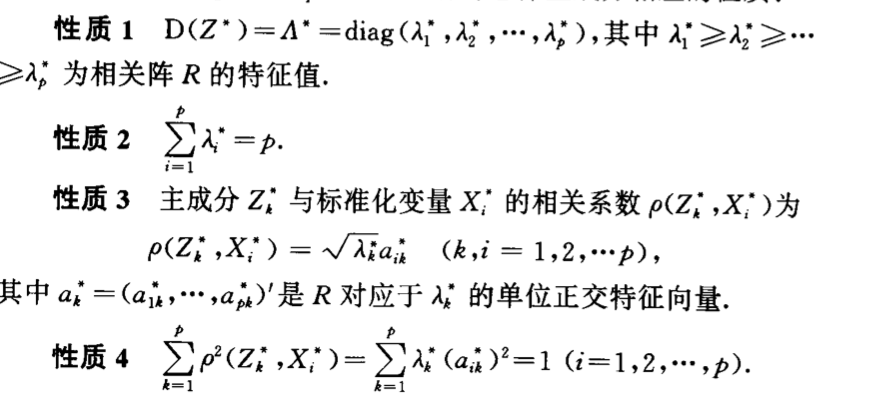
img 
img
3.2.3. sample PCA
Def:
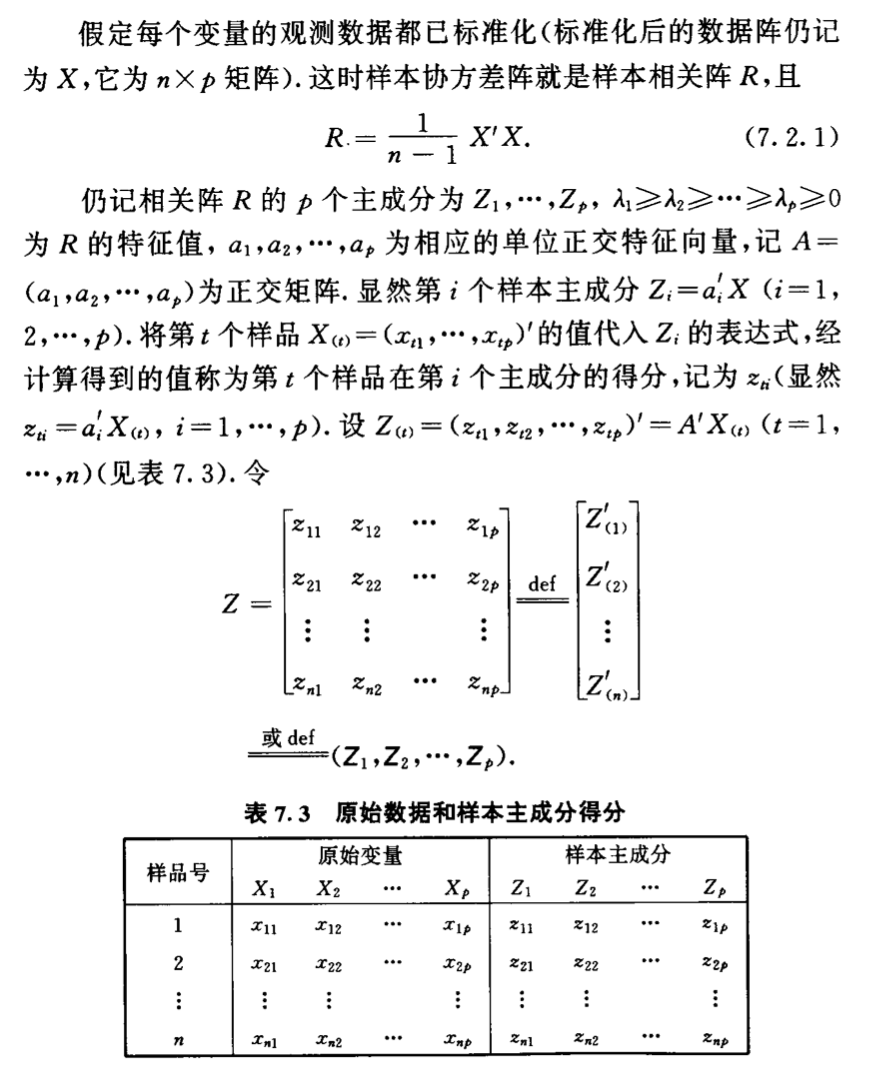
img 
img Qua:
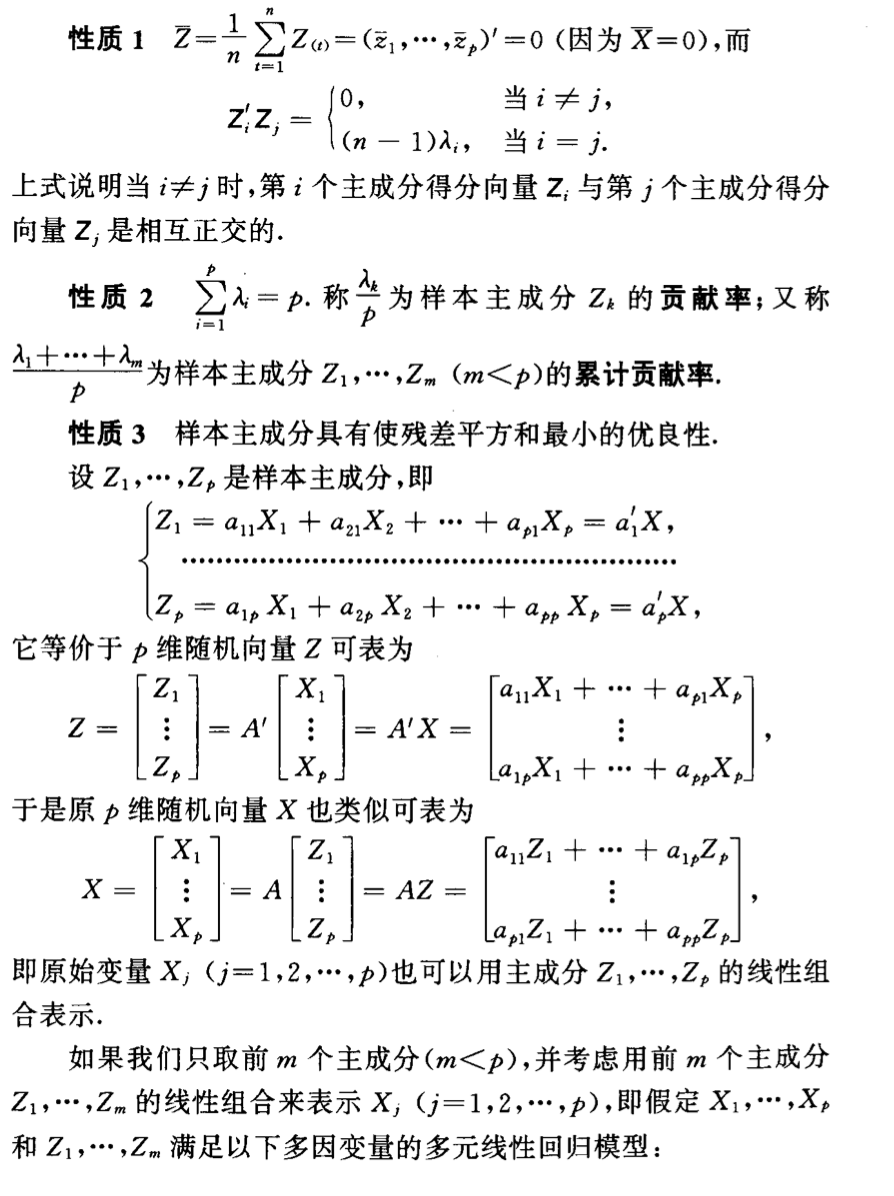
img 
img 
img
3.3. factor analysis
3.4. canonical correlation analysis
3.5. EM
Usage: input => data(X1,X2,...Xn), output => parameters concerning X's distribution, a step-wise & approximate algorithm of max likelihood.

img why can't use max likelihood? because it contains log of sum => hard to get derivative. Note that z does not appear on the left, it means that we can not observe z or other wise we can put \(p(y,z |\theta )\) together and get \(p(y,z|\theta)=p(z|\theta)p(y|z,\theta)=\pi ^{z}(1-\pi) ^{1-z}p^{yz} (1-p) ^{(1-y)z}q ^{y(1-z)}(1-q) ^{(1-y)(1-z)}=(\pi p ^{y}(1-p) ^{1-y}) ^{z}...\), this is very easy to estimate via max likelihood. The general idea is that with more data, the problem will become more easy to solve.

example of using EM algorithm

Def: Q function

Def: EM, hardest part is to get Q.


Note: some notices,

3.5.1. loss function
Def: max likelihood . This is the function we wish to maximize

this is the function we actually maximize

- Note: f comes from preset model with parameters (e.g. normal distribution)
- Note: \(\hat{f}\) comes from step-wise optimization with data.
3.5.2. optimization
Def: we want to use step-wise optimization

getting lower bound for the differentiate by Jensen

using lower bound to do step-wise optimization

Note: illustration very good => in each round, we maximize \(B(\theta, \theta_i)\) to get \(\theta_{i+1}\), then we get \(B(\theta, \theta_{i+1} )\) which is another lower bound curve and we seek for peak for that. this is a non-decreasing algorithm since B is lower bound and we always seek peaks on B.

3.5.3. convergence
Theorem:

Theorem:

Note:

3.5.4. alternatives & improvements
3.5.4.1. GMM
Def: GMM
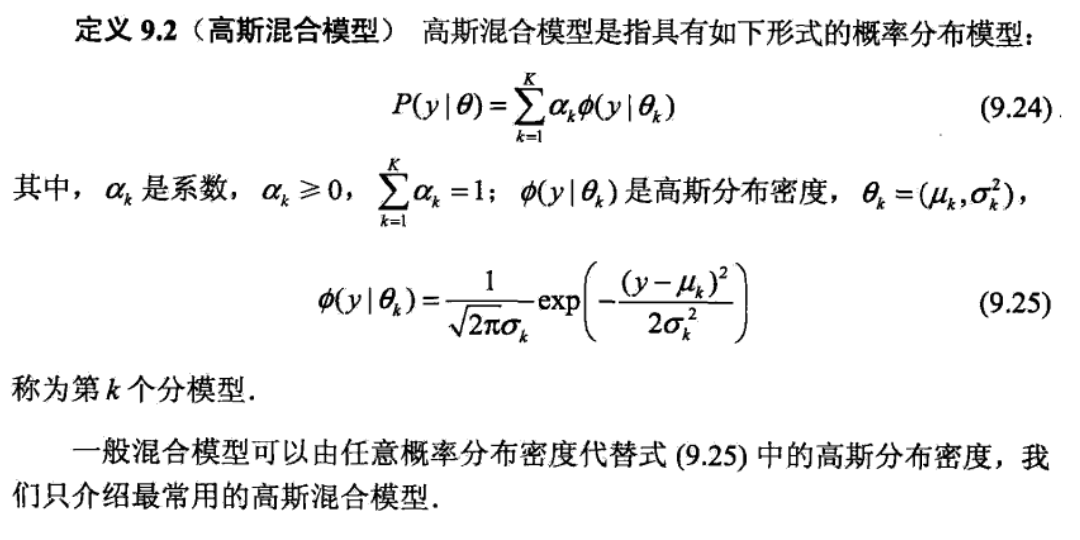
first we need to know what parameters to estimate, what hidden variables we don't know. Note that we can make up a hidden variable so that the post probability is the same => we can image we first choose randomly from 1->k and then generate result. The max likelihood function can be computed by full probability expansion/

define Q

expand Q

maximize Q

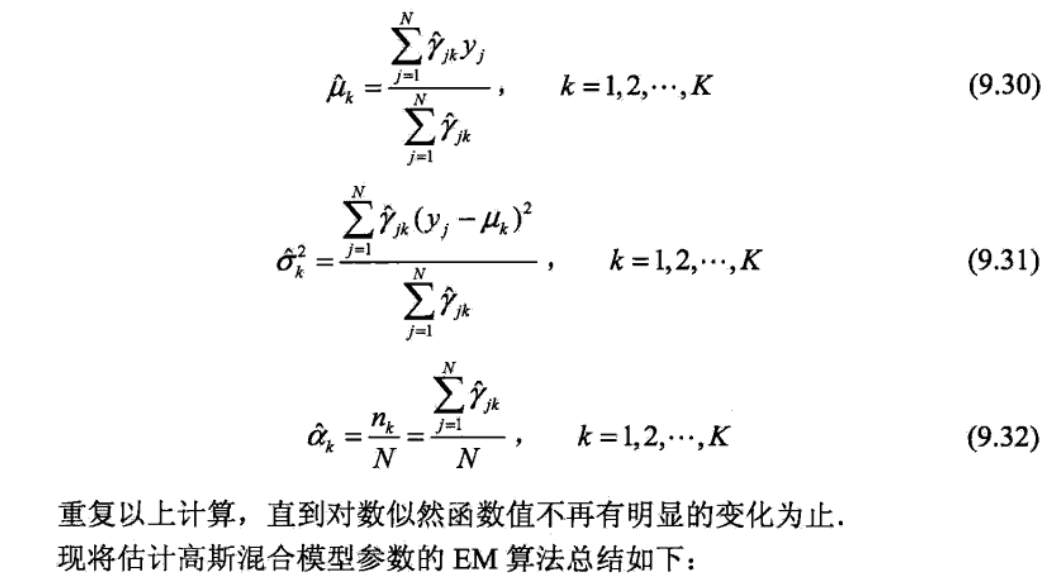
overall

3.6. markov algorithm
4. reinforced algorithms
lecture 2基本介绍了基本前置定理比如vc之类的;
lecture 1先是介绍了基本算法等,然后用average和hoeffding bound介绍了EPM思想。
lecture 3先是介绍了基本框架,然后用EPT证明各种bound,然用用这些bound介绍EPM思想。

